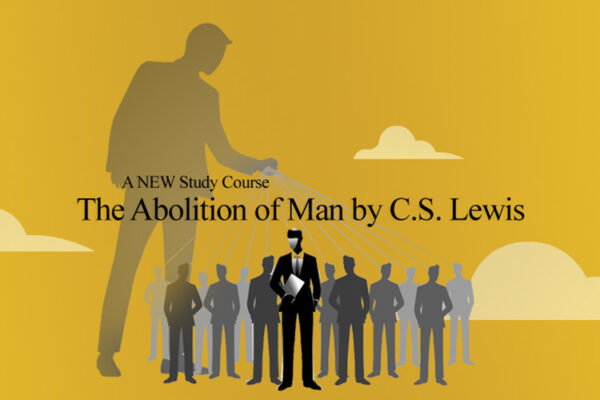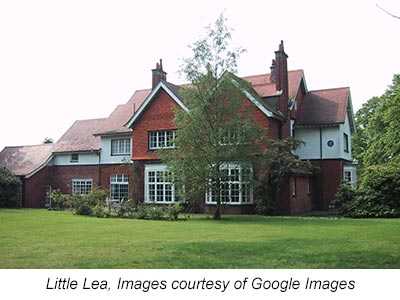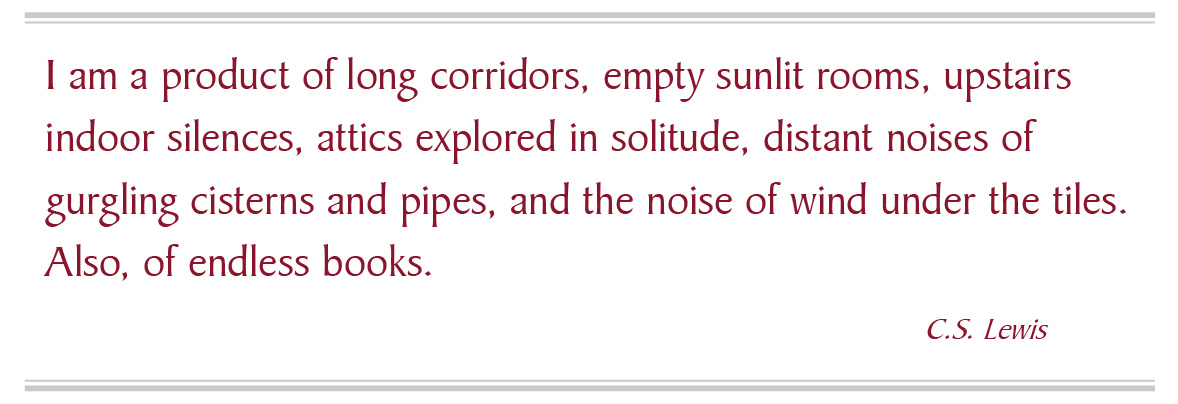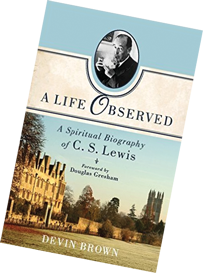Back to series


Recommended Reading:

Little Lea - (Part 1)
(This is a four-part series on Surprised by Belfast: Significant Sites in the Life of C.S. Lewis. Part 1, Part 2, Part 3, Part 4.)
Click here to open a Print - Friendly PDF
This four-part series explores locations in Belfast that have strong associations with C.S. Lewis and his family. These locations and the focus of the articles are (1) Little Lea, his boyhood home from 1905, (2) Dundela Villas, where C.S. Lewis was born in 1898, (3) St. Mark’s Church where Lewis was baptized in 1899, and (4) the University Quarter of South Belfast. Events that took place at these locations shaped Lewis’s early life and influenced it forever.
Those of us for whom the literary legacy of C.S. Lewis is a much-loved treasure can enhance our appreciation of his life and work if we learn a bit about Belfast, Northern Ireland, the land of his birth. The windows of our understanding of how his life was shaped by place can be opened by revisiting specific significant locations.
C.S. Lewis was born in Belfast on November 29, 1898. There are few weeks in a year that I do not drive along Dundela Avenue where he was born. And I even more frequently pass by the house, named Little Lea by Lewis’s father, to which his family moved in 1905.
This house is on Circular Road in Belfast, and for several years I lived just a few houses away. Even now I live only a short distance from Little Lea. My awareness of the former Lewis house is partly a simple consequence of where I live, especially in relation to my daughter’s home on Circular Road. I also frequently lead tour groups to the locations in Belfast and throughout Northern Ireland that have associations with Lewis and his family. Little Lea is a significant stop on these tours.
In addition, I give talks about C.S. Lewis to a wide range of groups. These activities provide opportunities for me to describe the house, the site’s significant events, and how these events shaped Lewis’s life. Each time I see the house, I’m reminded of aspects of his life, of things he said about them, and of things he said in consequence that have the potential to influence our lives, even decades after his death.
Little Lea occupies a large lot on Circular Road. Lewis tells us in Surprised by Joy that his father chose the site mainly for the view. In 1905 the Lewises had an uninterrupted view from their front door over the wide fields to Belfast Lough, to the Antrim Shore and the distant skyline of the mountain peaks: Divis, Colin, and the Cave Hill. Writing in 1955, Lewis describes the house as “a large one, even by my present standards.”
1Today, although some aspects of the view might be altered slightly, not much else has changed. Little Lea still occupies a location characterized by the calm maturity of a leafy city suburb. The road is arched by tall trees, with girth to match their years. In summer when the leaves are heavy, it is almost tunnel-like. Around the garden, the tall hedges have thickened to secure the privacy of the site. The posts of the electrically operated, wrought-iron security gates feature the words Little Lea and Private. The driveway winds from the road, flanked by colorful floral borders along the well-kept lawns, and leads around to the front of the house. It is the epitome of all that is calm, mature, and secure.
Shortly after Lewis’s family moved to the new house, his brother, Warren, was sent off to school in England. At Little Lea, Lewis’s mother taught him French and Latin and a local teacher, Annie Harper, taught him the remaining curriculum. His lasting memories of these years, 1905–1908, revolve around his mother, Annie Harper, and members of the extended family and household who were on hand for conversation. He remembers the solitude he enjoyed in the large gardens and in the spacious attics. He also remembers having unrestricted access to all his father’s books. It was in Little Lea that Lewis began his education. His first book, Boxen,2 although not published during his lifetime, took shape there, and there he wrote his first poems.
 In Little Lea and its surroundings, Lewis formed his early memories. One significant event above all others effected a major change on the Lewis family. C.S. Lewis traces its beginning, insofar as it affected him directly, to a cold winter evening in 1908. He vividly recalls the scene. A small medical team had arrived at the house on that February day.
In Little Lea and its surroundings, Lewis formed his early memories. One significant event above all others effected a major change on the Lewis family. C.S. Lewis traces its beginning, insofar as it affected him directly, to a cold winter evening in 1908. He vividly recalls the scene. A small medical team had arrived at the house on that February day.
Young Lewis anxiously noted that although he was feeling unwell himself, his mother did not come to him. She also was unwell, and the medics attended her in her room. He sensed the uneasy tension in the house. His father was distressed, and the other adults exhibited a heightened anxiety. Lewis was eventually told that his mother had cancer. In 1908 the medical options for treatment were few; when he realized that his mother’s condition was hopeless, Lewis began to pray. As a child he had been taught to say his prayers, and as a child his understanding was that sincerely offered prayer requests would be granted. He prayed for his mother’s recovery—and then she died.
Some of the consequences of his mother’s death were immediate but not necessarily permanent. Others materialized gradually but were irreversible. One immediate effect was the termination of his schooling at Little Lea. His father sent him to a boarding school in England. Understandably, given the events that led to this, it was not a happy period for young Lewis. His schooling in England was temporarily reversed when in 1910 his father brought him back to Campbell College in Belfast. Although he attended the school for only a short time, it was a welcome reversal of fortune. The more permanent feature suffered by Lewis after his mother’s death was his loss of security.
When I pass Little Lea on Belfast’s Circular Road, I remember two things: his loss of security and his childhood prayer. It is instructive to read carefully his observations on this loss and also on prayer.
The features of his life before 1908 were characterized by descriptors that could, in a different sense, equally apply to Little Lea itself. The house had all the attributes of what appeared to be established, secure, tranquil, and permanent. Today it still exudes the kind of images conjured up by these words. Lewis recalls that his childhood, as distinct from his boyhood, was characterized by a general, humdrum happiness. His early life in the house appeared to be insulated from anything that was detrimental and nurtured by all that was steady, constant, and beneficial.
Reflecting on Lewis’s life at Little Lea, I have come to appreciate allusions he made to the property, and I want to focus on three of them.
The first concerns the feelings about his early life as expressed in his letters and poems. In a letter dated April 29, 1930, to his Belfast friend Arthur Greeves, he summarizes in a few sentences his darkest memories about the worst of the events he experienced at Little Lea. Fortunately, a few sentences later in the same letter, he warns Arthur not to conclude that the things he has written dominate all his thinking.
He is careful to point out that the act of writing about events or things tends to make them appear bigger features than they actually are. It is good to remember this advice, particularly when we read some of Lewis’s early poetry, which recalls the unhappy times. One poem in particular, titled “Alexandrines,” evokes a fairly gruesome memory, of a house and a little room within that house that holds a particular terror for the author:
For in that house I know a little, silent room Where Someone’s always waiting, waiting in the gloom.3
Given what we know of Lewis’s childhood story, it is difficult not to conclude that the subject of the poem is Little Lea.
Another of his early poems, written in 1917, commences with a description of a house (clearly Little Lea):
The big, red house is bare and lone
The stony garden waste and sere
With blight of breezes ocean blown
To pinch the wakening of the year;
My kindly friends with busy cheer
My wretchedness could plainly show.
They tell me I am lonely here—
What do they know? What do they know?4
There is very little about Little Lea that on a fine summer day, in settled weather with blue skies, would create the illusion of red. The color green springs to mind: the green of the lawns, the plants, the trees, and the leaves. But I have some photographs of the house taken on a clear winter day a few hours before sunset and with snow in the air; the cladding, the roof tiles, and the brickwork take on a distinctly reddish glow.
While neither of these poems creates an image of a place that is remembered with unalloyed warmth and affection, the same could not be said of his poem “Ballade of a Winter’s Morning”:
The wasted garden wan and bare
Is flooded o’er its flowerless beds;
So think no more to wander there
But rather by this cheerful glare
Draw up beside me, friend by friend
A snugly cushioned easy chair—
A merry morning we shall spendThe rain is pattering on the leads
But we this crackling blaze will share
And take fit books for drowsy heads
To bend above in easy-chair.5
Based on comments by his brother, this poem is thought to be of a morning in Belfast, at Little Lea; while the rain pours down on the roof, Lewis and Arthur Greaves share the warmth and glow of a crackling fire. The poem was written at Christmas 1915, one hundred years ago; it celebrates a friendship that commenced on Circular Road and would last for almost half a century.
I note a second main feature when I look at Little Lea in relation to Lewis’s childhood: its uninterrupted, humdrum happiness. The impression we get from looking at the house is consistent with Lewis’s description of the household’s ordered tranquillity. Like all of us, he had no idea how life events were going to unfold, but as he looked back he knew how dramatically his life was changed by the household’s loss. He describes it like this:
With my mother’s death all settled happiness,
all that was tranquil and reliable disappeared
from my life. There was to be much fun, many
pleasures, many stabs of joy; but no more of
the old security. It was sea and islands now;
the great continent had sunk like Atlantis...
All security seemed to be taken from me; there
was no solid ground beneath my feet.6
Third, when I look at the house, I am reminded not only of these events, but also of the quotation Lewis uses as the epigraph of chapter 1 of Surprised by Joy. Most readers probably pass over the quotation, which takes on its true significance only after the chapter has been absorbed and understood. By the time most readers have started chapter 2, they might never again glance at the quotation placed at the beginning of the book. It is from John Milton, and it reads: “Happy, but for so happy so ill secured.”7

When the blows of change, as Lewis calls them, began to fall in the idyllic surroundings of Little Lea, they were not only unwelcome and unanticipated; they were also unstoppable and irreversible. The things that appeared tranquil, robust, and secure were, in reality, so ill secured. Ultimately Lewis says, “In all seriousness I think the life of faith is easier to me because of these memories.”
8The great lesson that he learned and that he passes on to all who would be disciples of Christ is this: “We have learned not to take present things at their face value.”9 Present material things and circumstances are ill secured, transient, and passing.
In a lot of his writing, in at least four significant places, Lewis gives serious consideration to the topic of prayer: Letters to Malcolm, Surprised by Joy, and in the essays, “The Efficacy of Prayer” and “Petitionary Prayer: A Problem Without an Answer.”
All of these pieces, which I recommend to readers, include potentially helpful observations. As I read Lewis, I am encouraged by the fact that he raises questions that can trouble any of us about our Christian faith. He does not duck the issues, nor does he allow the perceived difficulties to dent belief or practice. In Surprised by Joy, he reflects on the childhood prayer offered at Little Lea for the recovery of his mother.
There he is quite clear that neither his mother’s death nor the ineffectiveness of his sincere, childhood prayer was a significant cause of his years of his unbelief. Nor did his childhood experience of prayer become a problem later, when as a Christian he prayed. In regard to prayer, the mature Lewis notes that whatever prayer is, and no matter how we think it operates, we are not to think of it and not to use it as we think of machinery or as we use machines. It is not a handle that we turn and, as a consequence of some predetermined algorithm, obtain a specific and desired result.
Lewis also warns against thinking of prayer as some might think of magic. There is no formula for producing required outcomes. Lewis comments instructively on the childhood prayer he offered at Little Lea. Having reflected on the event for some fifty years and having written extensively about prayer, he reminds us of some essential aspects of the prayer he offered on behalf of his mother. He had approached God, not as the sovereign Lord, but as some deity who might wave a wand and make unpalatable circumstances disappearz
His approach to God was faulty. He says in Surprised by Joy,
I had approached God, or my idea of God, without love, without awe, even without fear. He was in my mental picture of this miracle, to appear . . . merely as magician; and when He had done what was required of Him I supposed He would simply—well, go away.10
Elsewhere Lewis reminds us that Aslan is not a tame lion. He cannot at our bidding be led into a ring, placed on a three-legged stool, and be made to perform what we want. When I pass his boyhood home in Belfast, I often think about what Lewis said in relation to prayer. The words of the disciples recorded in the Gospels come readily to mind: “Lord, teach us to pray” (Luke 11:1).
They tell me, Lord, that when I seem
To be in speech with you,
Since but one voice is heard, it’s all a dream,
One talker apeing two.Sometimes it is, yet not as they
Conceive it. Rather, I
Seek in myself the things I hoped to say,
But lo! My wells are dry.Then, seeing me empty, you forsake
The listener’s role and through
My dumb lips breathe and into utterance wake
The thoughts I never knew
And thus you neither need reply
Nor can; thus, while we seem
Two talkers, thou are One forever, and I
No dreamer, but thy dream.11
Notes:
1 C.S. Lewis, Surprised by Joy: The Shape of My Early Life (Orlando, FL: Harcourt, 1955), 14.
2 C.S. Lewis and W.H. Lewis, Boxen: Childhood Chronicles before Narnia (New York: HarperCollins, 2008).
3 C.S. Lewis, Spirits in Bondage: A Cycle of Lyrics (London: Harcourt Brace, 1984), Part 2, Chap. 22, “Alexandrines.”
4 Ibid., “Ballade Mystique.”
5 Don W. King, ed., The Collected Poems of C.S. Lewis: A Critical Edition (Kent, OH: Kent State University Press, 2015), 234–35.
6 C.S. Lewis, Surprised by Joy (1955; report., London: Harcourt Brace, 1966), 23.
7 Ibid., 9.
8 Ibid., 35.
9 Ibid., 35.
10 Lewis, Surprised by Joy, 21.
11 C.S. Lewis, cited in A.N. Wilson, C.S. Lewis: A Biography (New York: W.W. Norton, 1990), 290.

Sandy Smith
AuthorSandy Smith, is the author of C.S. Lewis and the Island of His Birth and a Director of Heritage Experience. His book is available through www.authenticulster.com. Three short film pieces on aspects of the life of C.S. Lewis can also be viewed on the website. In addition he has produced several YouTube videos of Ireland.

Recommended Reading:
Devin Brown, A Life Observed: A Spiritual Biography of C.S. Lewis (Brazos Press, 2013).
Devin Brown brings C.S. Lewis’ story to life in a fresh, accessible, and moving biography through focusing on his spiritual journey. Although it was clear from the start that Lewis would be a writer, it was not always clear he would become a Christian. Drawing on Lewis’s autobiographical works, books by those who knew him personally, and his apologetic and fictional writing, this book tells the inspiring story of Lewis’s journey from cynical atheist to joyous Christian and challenges readers to follow their own calling. The book allows Lewis to tell his own life story in a uniquely powerful manner while shedding light on his best-known works.
 COPYRIGHT: This publication is published by C.S. Lewis Institute; 8001 Braddock Road, Suite 301; Springfield, VA 22151. Portions of the publication may be reproduced for noncommercial, local church or ministry use without prior permission. Electronic copies of the PDF files may be duplicated and transmitted via e-mail for personal and church use. Articles may not be modified without prior written permission of the Institute. For questions, contact the Institute: 703.914.5602 or email us.
COPYRIGHT: This publication is published by C.S. Lewis Institute; 8001 Braddock Road, Suite 301; Springfield, VA 22151. Portions of the publication may be reproduced for noncommercial, local church or ministry use without prior permission. Electronic copies of the PDF files may be duplicated and transmitted via e-mail for personal and church use. Articles may not be modified without prior written permission of the Institute. For questions, contact the Institute: 703.914.5602 or email us.
-
Recent Podcasts
Ralph Waldo Emerson’s Philosophy and Influence
by David George Moore on July 26, 2024Ralph Waldo Emerson was a gifted nineteenth century...Read More
-
The Side B Stories – Nate Sala’s Story
by Jana Harmon, Nate Sala on July 19, 2024
-
Terrorism Through the Eyes of Faith
by Dennis Hollinger on July 12, 2024
-
Recent Publications
Hasn’t Science Proven That Belief in God Is an Outdated Superstition?
by Sharon Dirckx on July 1, 2024Many assume that scientific practice and belief in...Read More
-
Has the Bible Been Corrupted as Some Muslims Claim?
by Andy Bannister on June 1, 2024
-
Seeing Jesus Through the Eyes of Women
by Rebecca McLaughlin on May 15, 2024
0
All Booked
0.00
All Booked
0.00
All Booked
22194
C.S. Lewis’s The Abolition of Man Live Online Small Group 8:00 PM ET
https://www.cslewisinstitute.org/?event=c-s-lewiss-the-abolition-of-man-study-course&event_date=2024-10-02®=1
https://www.paypal.com/cgi-bin/webscr
2024-10-02

Next coming event
Days
Hours
Minutes
Seconds
C.S. Lewis’s The Abolition of Man Live Online Small Group 8:00 PM ET
On October 2, 2024 at 8:00 pmCategories
Speakers

Sandy Smith
Author
Team Members

Sandy Smith
AuthorSandy Smith, is the author of C.S. Lewis and the Island of His Birth and a Director of Heritage Experience. His book is available through www.authenticulster.com. Three short film pieces on aspects of the life of C.S. Lewis can also be viewed on the website. In addition he has produced several YouTube videos of Ireland.






